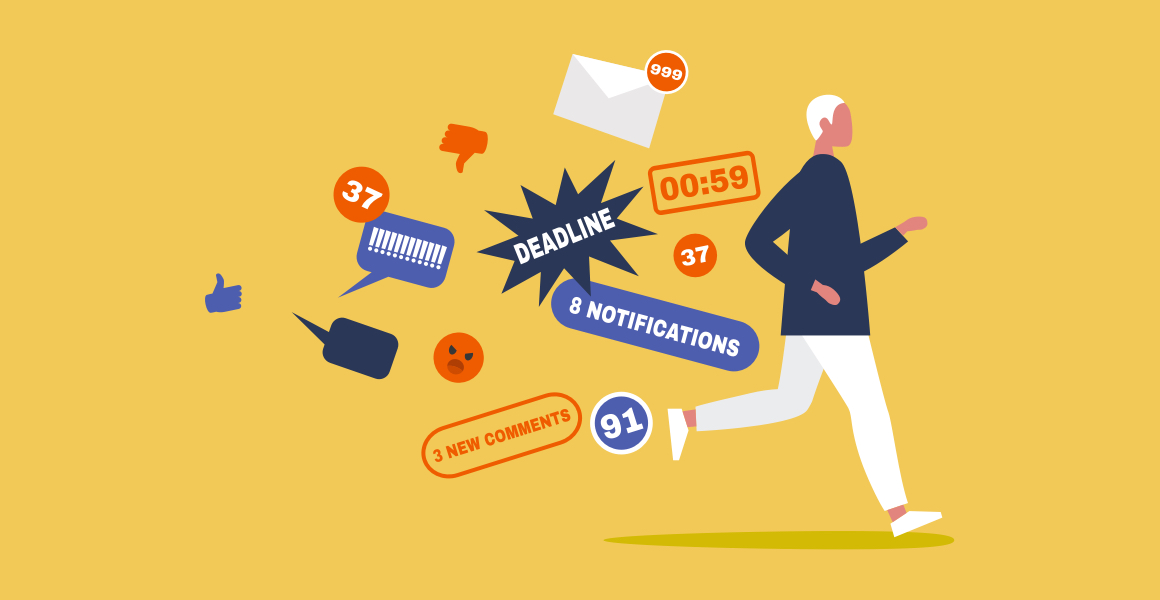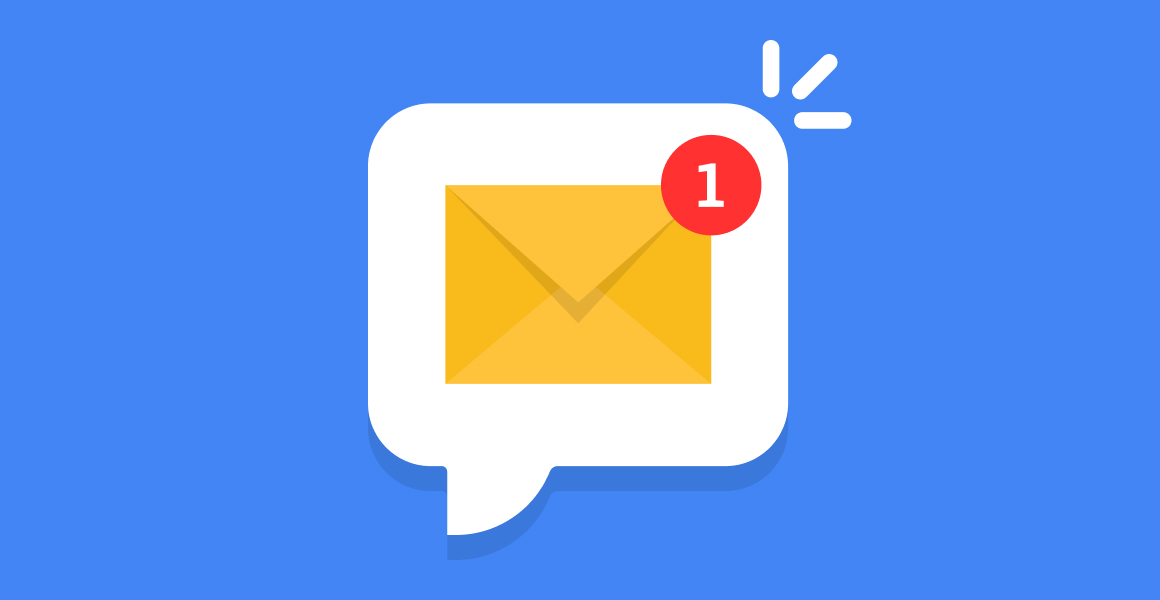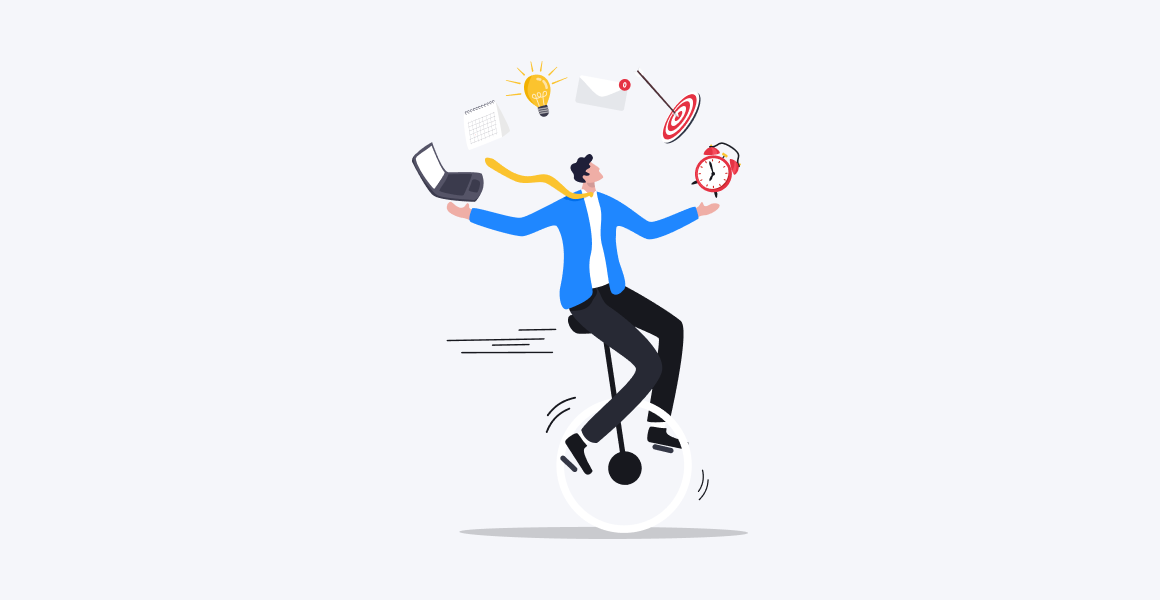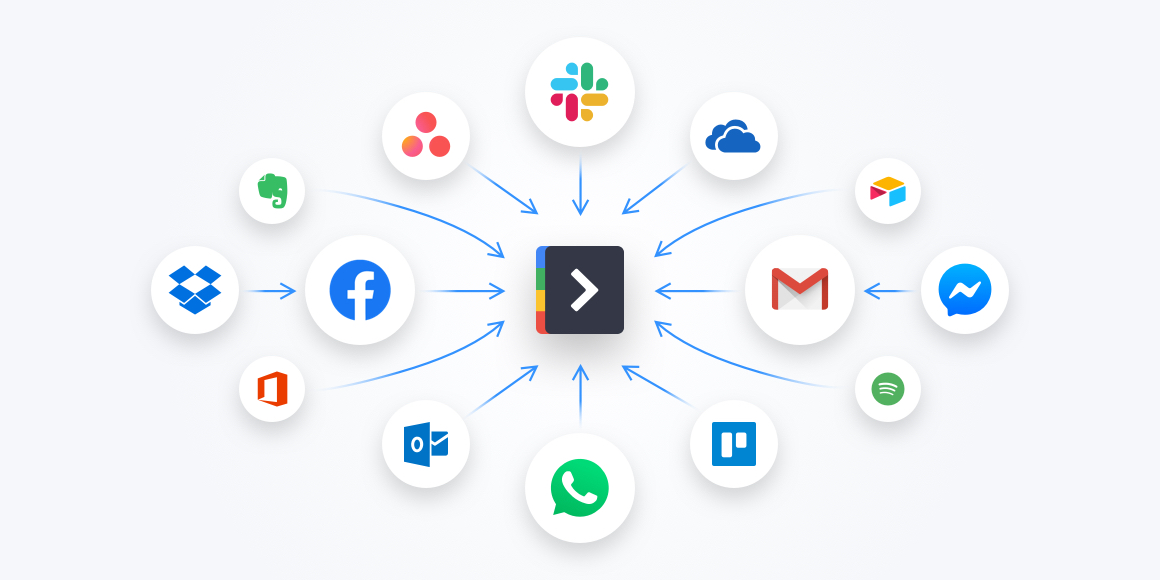Today’s environment offers nearly limitless tools and technology to enable productivity. With all of the various applications and platforms available, it should be easier than ever to manage your time and various to-do’s.
Unfortunately, that’s not the case.
The reality is that people rely on so many different apps - across phones, tablets, and desktops - that they need a special strategy just for managing their tech!
Science tells us that becoming more productive is based on changing behavior. The best productivity hack for you is going to depend on several factors: your goals, your strengths, working style, personality traits, the tools at your disposal, and so much more. Start by exploring some of the tried-and-true best practices for ramping up productivity and see what is right for you.
Without properly maintaining and organizing the technology you use, your productivity will only suffer. To help, we’re detailing some of our favorite productivity hacks for managing all of the apps you already use. Here we go!
Tips for Working with Multiple Apps
Once you’ve laid the groundwork with the tips above, you’re ready to dive into work. How can you make the most of your time when you’re working with various technologies all day? Start here.
Turn off notifications
Notifications are a necessary part of using today’s technology, but they can really end up being a hindrance. There’s a lot of research out there that shows that notifications can quickly cross a line from enabling productivity to being distracting and even inducing stress. Many studies are focused on mobile phone behavior, but we can assume the same concepts apply to behavior on a desktop. For example, a study from Deloitte found that people check their phone a whopping 47 times per day, and often in response to alerts. On a desktop, you’re likely getting notifications from at least one email account, a collaboration platform like Teams or Slack, your calendar reminders, social media platforms, and more.
If you use ten programs in a day, and each of them pings you with 3 notifications on average, that’s 30 notifications that cause you to stop what you’re doing and refocus. Thirty interruptions! Rather than trying to mentally ignore or prioritize notifications, just turn them off while you’re working. You’re likely to feel strange at first, as it can feel unnatural to tune the outside world out. However, remind yourself that turning notifications off is a gift you can give yourself to be more productive.
Related Post: How to Avoid Notification Overload
Use a notification aggregator
Impossible to turn notifications off? Most apps allow this, but some may not. Or, maybe you just can’t bring yourself to block those little reminders. Shift offers notification management that can apply across all the apps you use every day, from Outlook to Facebook to Slack and beyond. With a couple of clicks, you can mute all notifications temporarily or control the sounds that play when a notification comes through. Shift brings together all of the notifications from any of your apps and email accounts and displays them in one place. You don’t have to look in multiple places anymore just to see what new alerts you have. Instead, you can simply check the number that appears in the little red bubble on the Shift icon in your taskbar, and there you go! This is truly the easiest way to avoid overload from push notifications. Users save a ton of time that previously was wasted switching between apps and bouncing around from notification to notification.
Related Post: How to Get a Notification Aggregator for Desktop
Block distracting sites
The biggest time-wasters are often websites or apps that we love to use. Be honest: how much time do you spend on social media when you’re procrastinating? If you are serious about focusing on work and boosting productivity, try blocking certain websites all together. There are specific tools that can help you with this if you don’t have the discipline to block them yourself.
Quit multitasking
These days, we pretty much acknowledge that multitasking is a myth. In truth, multitasking is a great way to accomplish nothing at all. Research from Stanford University proves that multitasking actually does more harm than good. According to their research, multitasking can not only interfere with working memory, causing people to perform worse at their tasks, it can cause problems with long-term memory storage too. Shifting between tasks also causes a loss of accuracy and speed.
We have seen the error of our ways and most experts agree that focusing on one thing at a time is incredibly beneficial. In fact, multitasking can increase anxiety and cause the release of stress hormones. Though you may get some instant gratification from switching back and forth between tasks, multitasking is actually a productivity killer. Rather, it’s a good practice to focus on monotasking (trying to complete one thing at a time). You might do so without even realizing you are, and the practice is called monotasking. Manage one task at a time, and you’re likely to find that your productivity skyrockets. This is often easier said than done, so start small. Try choosing a few hour-long chunks of time in your day where you commit to working with a singular focus. Gradually, those chunks of time can get longer as you become proficient and comfortable with monotasking.
Related Post: The Problem with Multitasking (and How to Solve it!)
Take breaks
Does it sound counterintuitive to take more breaks during your workday? It goes against what most of us were trained to do, but research shows it can be incredibly beneficial. Taking regular breaks is actually critical for maximum efficiency. One study showed that about 12% of your total day should be dedicated to breaks. In an eight-hour day, that’s a bit under one hour. Most experts also agree that short breaks scheduled throughout the day are more beneficial than one longer break. Those who take 4 or 5 breaks during the day are likely to be more productive in the long-run. Even a “micro-break” of 2 or 3 minutes where you close your eyes or stand and stretch can be helpful. It’s important to take some time to shut your brain off, move your body, and re-focus. You’ll get a lot more done over the long-term.
Tune into special music
Music can help people work better and lift their mood. If you’re a music lover, that’s not a surprise to you. Though it doesn’t always make sense to have music playing at work, it can help to increase your focus during productive spurts. How impactful music is going to be depends on the type of work that needs to be done. Some studies have shown improvements in both speed and quality of work with music playing in the background. Some people say that music is distracting and has the opposite effect. Really it depends on your own personality and preferences, but you shouldn’t be afraid to give music a try if you’re looking for a little extra inspiration and focus.
Preparing for Productivity
As you have probably figured out, productivity is not something that just happens. Being productive doesn’t happen by accident (although some people do seem to have a knack for just getting more done), it’s the result of a culmination of activities. How can you set yourself up for success? Let’s start with the fundamentals.
Gather your energy
A recent poll found that late morning (around 11 am to be exact) on a Monday morning is when people are most productive. In fact, research has shown for a long time that morning tends to be the best time of day to get work done. Many productivity methods suggest starting out with your toughest tasks for just that reason. That being said, you’re unlikely to jump out of bed ready to take on the day if you’re over-tired or stressed. It’s important to get enough sleep - ideally 7 to 9 hours. If you are planning a big productivity push, you need to set the foundation beforehand. Eat well, stay hydrated, get some sleep, and clear your mind. You must have the energy to power through your workday, or you’ll soon feel defeated. We suggest implementing a consistent sleep schedule complete with meditation and quiet time before sleep. Maintain this schedule with plenty of sleep for at least a few days before you implement other productivity hacks.
Choose the best tools (for you)
The importance of picking the right tools cannot be overstated. There are a lot of productivity, time management, and task-related tools at your disposal. Some are more complex and some are more intuitive. The most important thing is to choose platforms that align with your natural workflows. If you install a tool and then find that you’re not using it, that is a sign. If you aren’t finding the tool user-friendly, that’s another sign. Stop using it and explore other alternatives before you waste more time. You can get more insight into great tools to try in our past articles.
Set a realistic number of daily goals
If you find yourself with 20 incomplete tasks at the end of the day, you might be over-extending yourself. Pushing yourself too far and not being able to accomplish your tasks is a good way to become discouraged and give up - and that’s the opposite of what you want. Ambition is an important part of setting goals, but they need to be attainable.
There are a few different schools of thought when it comes to daily goal-setting. Some principles say to set 3 main goals for each day. Others say to focus only on goals that relate to your most important objectives. Or, you can use some proven techniques like the Ivy Lee method or the Eisenhower Matrix for time management. Regardless, it’s important to be honest with yourself about what can really be accomplished in a given day. It’s worth noting that this may require seeing what you normally do on a typical day, and it may be necessary to have a discussion with your manager. There might be a change in expectations needed.
Related Post: How to Use the Eisenhower Matrix for Maximum Productivity
Group tasks by intuitive categories
You probably don’t realize it during a normal day, but jumping between tasks and getting into different mindsets takes up a lot of mental energy. You might be surprised to learn how much time can be wasted by doing one set of tasks, then moving on to something unrelated, then coming back to your original projects. Email is a great example. It takes vastly more energy to check email throughout the day than it does to set a few specific times to check email. Every time you check you might have to respond to someone, which could involve looking something up or searching for something. If you keep doing this in the middle of tasks it poses a huge interruption.
Task-batching can help with this. That’s the practice of grouping similar tasks together, either by the type of tasks or the skills required. People who practice this tend to reduce fatigue and stay more focused. Plus, you can save the time that you previously spent physically moving into different areas throughout the day. To get started, you might group tasks and make a to-do list based on the people you need to speak to that day or working in a certain computer program.
Moving Forward: A More Productive Mindset
A really productive day is a big accomplishment on its own. It’s a wonderful feeling to end the day with a marked-off to-do list. How can you do the same the next day - and the next? You need to implement some best practices that keep you motivated and productive over the long-term. Start with these tips:
Schedule time for using critical applications
When something is a priority, it’s important to schedule time for it. That’s true of things like exercise, studying for certifications, or seeing extended family. It’s also true of work and it’s especially true for using technology. No doubt there are some tools and platforms that are necessary for doing your job. We suggest batching these tasks and then completing them at a designated time. For example, if you have a lot of work to do in your Salesforce CRM app, you may want to plan on that work from 9 am - 11 am. Then commit to yourself that you’ll step away and focus on another task. Otherwise you may become distracted and start to lose productivity, or you might go down a rabbit hole and waste an hour without knowing why. It’s long been suggested to use time-blocking to make the most of your day. The same principle holds true for the various technologies in your life.
Note: Shift can help with this in several different ways. For one thing, you can set up focused browsing by account. Focused web tabs inside Shift offer a more productive web experience. You can also create and organize your workflows with mission-critical tabs, bookmarks, and apps for you or your team. Essentially, you can set up workspaces that allow you to stop logging in and out of various accounts, and dial into the apps that you need to be your most productive. You can explore Shift here.
Apply the 80/20 rule
This principle dictates that 80% of our total output comes from 20% of our input. Meaning: a large portion of our energy is ultimately misplaced, or not actually effective for our particular goals. That’s why we sometimes have days where we feel like we worked a ton, but accomplished nothing. When considering the best ways to use apps and spend your time, keep this rule in mind. Which platforms are actually impactful for you and which tend to be a waste of time? Which ones are most crucial for the work that adds value in your job or life? Make a list of all of the apps you use, even the ones you use rarely. Then review them one by one and be honest about how much time you spend being productive with each. Sort them according to the 80/20 rule and then carefully review the list and consider removing some, or at least moving them to the background and turning off notifications. Obviously, there are some tools or apps that are probably required for your work and you can’t just remove them. For example, Slack or QuickBooks. However, the key is to make sure you spend time proportional to their value. Set limits for how often you will use them each day and ensure that the activities you’re doing in there are essential for larger goals.
Evaluate your performance periodically
After you’ve managed to impose some best practices and you’ve experienced a bump in productivity, don’t give up. Your work isn’t done! You need to continuously review your relationship with technology and see where adjustments need to be made. We suggest pulling monthly reporting on your app usage from your computer. For example, you can do this in Microsoft by going to Reports. Navigate to Microsoft Managed Desktop > Managed devices. Then, select the Reports tab. Select Application usage. You can pull similar reporting on a Mac. Look over the list of apps and your screen time usage and see where you’ve improved and where you are wasting time. Then, make decisions about apps moving forward based on that information. You can take things a step further by determining how added productivity has impacted your goals. Did the additional focused time help you to get more done at work, improve relationships, shorten work timelines, etc? Make a list each month of the ways that added productivity is helping you and then keep those lists and review them at the end of the year. This kind of documentation can add serious motivation when you feel like you’re not getting anywhere. Chances are you’ll find that you’ve done so much more than you think!
Related Post: How to Get All Your Apps in One Place
Use Shift to Manage All Your Apps in One Place
Shift is an innovative platform that can be used for a better, more organized digital experience. You can use Shift to limit distractions, keep important context in your web tabs and apps, and increase overall efficiency.
One of the best features of Shift is that it eliminates endless logging in and out. For people who manage multiple accounts - for example, for those who use several Gmail accounts - this is a huge time saver and reduces confusion. Furthermore, you can easily access and store tabs and bookmarks in Workspaces. This makes it simple to have important tabs on-hand and organized by workspace, then bookmark them for quick access later on.
Anyone who uses online platforms will find Shift to be a powerful resource. With Shift, you can organize and manage the following:
- Mail - Connect all of your Gmail, Outlook, and Office 365 accounts and manage everything from one centralized workstation.
- Apps - WhatsApp, Slack, Messenger—we have everything you need to get it done. Browse our Apps Directory, connect yours, and switch between them easily.
- Search - Save time and find exactly what you're looking for across any of your Mail, Calendar, and Drive accounts.
- Chrome extensions - Enjoy access to Boomerang, Grammarly, LastPass, and many of your other favorite Chrome Extensions.
- Workspaces - Create a Workspace with the exact apps, tabs, and bookmarks you need, then share it with your team to get the job done.
- Account management - Toggle between your most-used accounts, check notifications and streamline your workflow.
Being more productive is a goal that almost everyone has. In today’s landscape where everyone is asked to do more with less, and we are constantly bombarded with various stimuli, it’s important to be realistic about how tools can add to - or take away from - your productivity. Try implementing these hacks to get the most out of the apps that you already use. And, make sure to follow our blog where we cover all the tricks, tips, and updates you need to be your most productive.




















 Share on Facebook
Share on Facebook Share on Twitter
Share on Twitter







